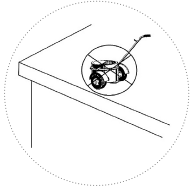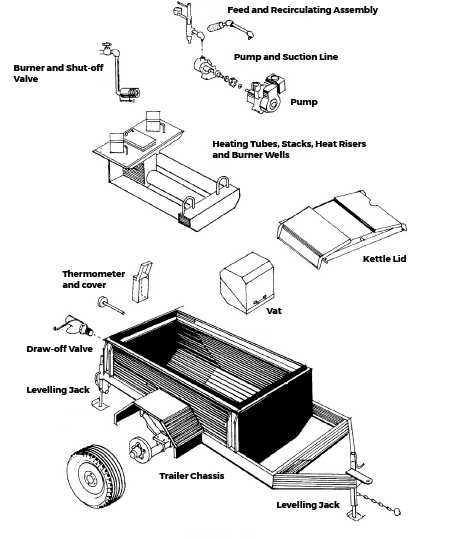Everyone in the roofing industry must be familiar and comply with the safety rules for handling hot bitumen. Knowledge of the general procedures and methods of roofing should be acquired before handling any hot bitumen. Such knowledge is necessary in order to know where and how to carry and place the buckets, safe filling level and when materials are needed. Personnel handling hot bitumen must be properly trained in the dangers involved. Hot bitumen should never be carried by untrained or inexperienced personnel.
The following are precautions when handling hot bitumen.
- Always wear the proper clothing and protective equipment when handling hot bitumen.
- Always walk flat-footed on a roof.
- Always have a clear path and look out for pipes, anchors, jacks, openings and other tripping hazards.
- Never lift a filled bucket above hip height.
- Wood sheathing or deck should not be less than 12.7 mm (1/2 in) thick and supports located not more than 400 mm (16 in) on center for the minimum thickness. If in any doubt as to the strength of the roof deck, refer to the superintendent or job foreperson before proceeding with work.
- Be sure the deck or sheathing are free from excessive loose talc, mica, mineral granule and sawdust, especially on pitched roofs. Also, be sure that the roof is constructed to carry the weight of workers and materials safely.
- Never carry hot bitumen on a roof that is covered with frost, dew, or ice and above all never over snow. Always clear a walkway. If you do not, there may be unseen obstacles covered.
- Do not fill the bucket more than 100 mm (4 in) from the top.
- Do not walk on the roofing membrane that has just been mopped. It can be slippery if the asphalt is still hot or sticky enough when cooled to cause you to trip.
- Never place buckets or mop buggies within 2 m (6½ ft) of an unguarded roof edge.
- Place the bucket of hot bitumen away from the mopping area and let roofers know where it is, so they will not trip over it when they back up.
 Pour hot bitumen slowly to help prevent splashing. If the hot bitumen should flash due to overheating, set it down quickly but carefully to avoid spilling or splashing of the bitumen and to facilitate control of the flame. The flame will not hurt you as much as the hot bitumen. Smother a flame by covering it with felt or other material.
Pour hot bitumen slowly to help prevent splashing. If the hot bitumen should flash due to overheating, set it down quickly but carefully to avoid spilling or splashing of the bitumen and to facilitate control of the flame. The flame will not hurt you as much as the hot bitumen. Smother a flame by covering it with felt or other material.- When pouring hot bitumen, pour only one bucket at a time.
- Never overfill a mop bucket. When mop is placed in an overfilled bucket, the hot bitumen could spill over the roofing or deck.
- On steep roofs, carry one bucket of hot bitumen at a time. If you should fall, it is easier to avoid the bitumen from one bucket than from two buckets. Also, never try to grab a falling bucket, as the hot bitumen may splash you.
- When taking a hot bitumen bucket off a hoist line make sure it’s up high enough to clear all obstacles. If on a high roof and the hoist operator on the ground can’t see if the bucket is high enough to clear the parapet or other obstacles, it is your duty to direct them to the proper height. Make sure the bucket has come to a full stop, before you attempt to bring it onto the roof. Always make sure you are using appropriate travel restraint/fall arrest measures and that one hand is holding onto the frame of the hoist or something solid. With the other hand gently bring the bucket onto the roof.
- Set the bucket you take off the hoist line far enough back on the roof so you will not trip over it.
- Always ensure that buckets are properly secured to the hoist line. Never send down more than one bucket unless both are secured properly. If bucket(s) should fall, they can cause serious injury to others below or damage equipment and/or the walls and other surfaces can be splashed with bitumen.

Typical Kettle Components
